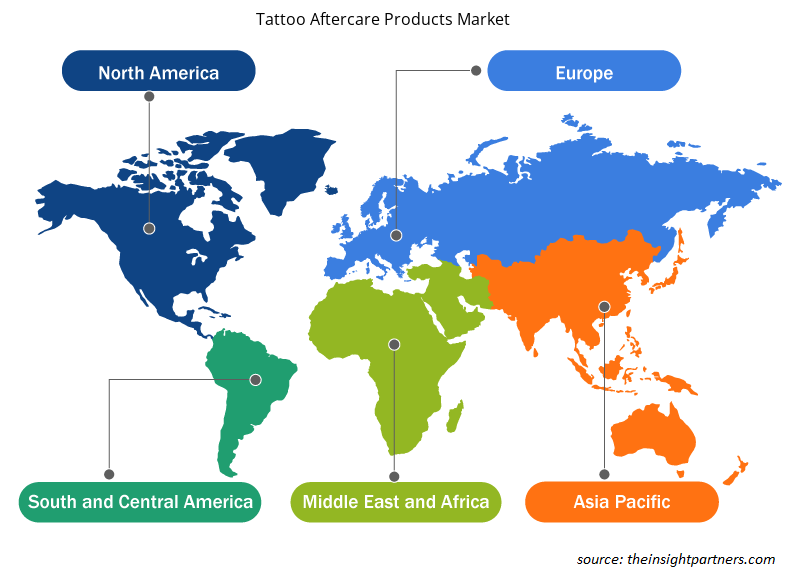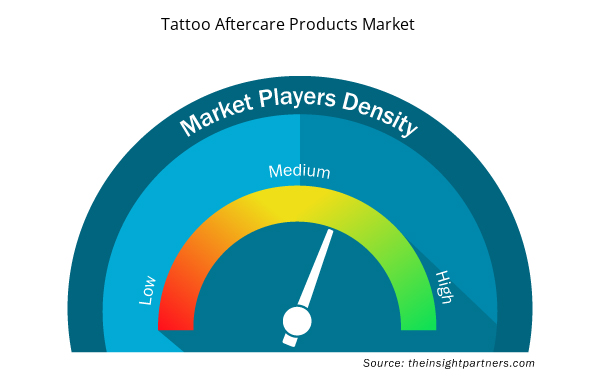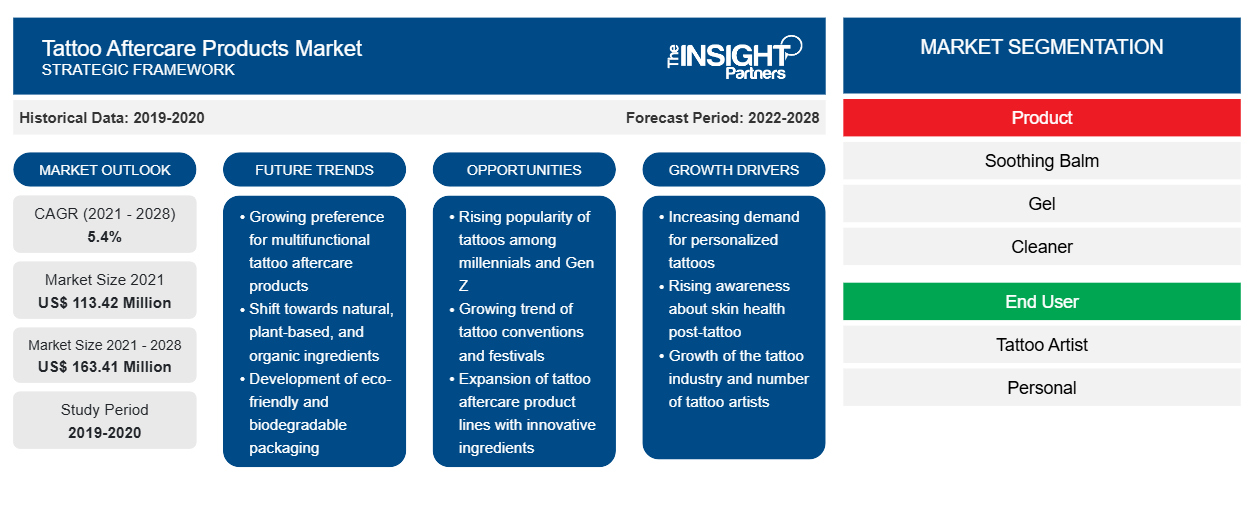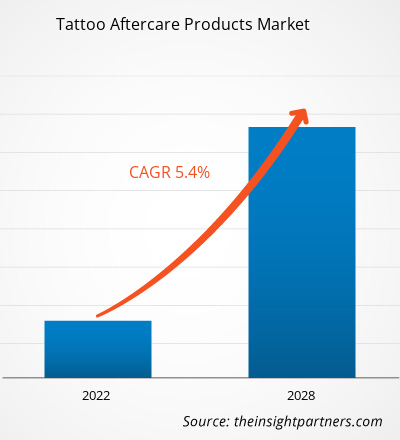Si prevede che il mercato dei prodotti per la cura dei tatuaggi crescerà da 113.418,08 mila dollari USA nel 2021 a 163.410,59 mila dollari USA entro il 2028; si stima che crescerà a un CAGR del 5,4% dal 2021 al 2028.
I prodotti per la cura post-tatuaggio sono un tipo di prodotto per la cura della pelle formulato appositamente per aiutare a proteggere il tatuaggio da tutti i tipi di danni e infezioni. Alcuni dei vantaggi dei prodotti per la cura post-tatuaggio includono il mantenimento della freschezza del tatuaggio appena forato, la riduzione del tempo di guarigione della pelle e l'aiuto nel mantenimento della luminosità e del colore del tatuaggio. Alcuni dei prodotti per la cura post-tatuaggio comunemente usati sono idratanti, balsami, lozioni, detergenti, detergenti schiumogeni, unguenti e altre preparazioni. Questi prodotti aiutano anche a mantenere il tatuaggio in condizioni ottimali. Fattori come il crescente numero di persone che si fanno tatuaggi e la crescente attrazione dei consumatori verso la bellezza e il benessere in tutto il mondo stanno stimolando il mercato globale dei prodotti per la cura post-tatuaggio . Tuttavia, gli effetti collaterali dell'uso negligente dei prodotti per la cura post-tatuaggio ostacolano la crescita del mercato.
Personalizza questo report in base alle tue esigenze
Riceverai la personalizzazione gratuita di qualsiasi report, comprese parti di questo report, o analisi a livello nazionale, pacchetto dati Excel, oltre a usufruire di grandi offerte e sconti per start-up e università
- Scopri le principali tendenze di mercato in questo rapporto.Questo campione GRATUITO includerà analisi di dati che spaziano dalle tendenze di mercato alle stime e alle previsioni.
Approfondimenti di mercato
L'aumento del numero di persone che si fanno i tatuaggi rafforza la crescita del mercato dei prodotti per la cura dei tatuaggi
I tatuaggi sono comunemente usati come simbolo di stile di vita dalle persone per presentare la loro cultura e il loro tenore di vita. La continua espansione nel settore della moda e dell'intrattenimento e il crescente interesse delle persone per un aspetto attraente ed elegante hanno guidato il mercato dei prodotti per la cura dei tatuaggi. Poiché la necessità di espressione artistica è aumentata a causa dell'influenza di programmi TV, piattaforme di social media, riviste digitali e altri canali di intrattenimento, le persone scelgono di farsi tatuare per una serie di motivi. L'aumento del numero di persone che si fanno tatuare ha anche aumentato la necessità di prodotti per la cura dei tatuaggi, che è un fattore positivo per il mercato in questione.
La crescente demografia di potenziali clienti per il mercato dei prodotti per la cura dei tatuaggi sta aumentando la domanda di vari prodotti per la cura dei tatuaggi. Ad esempio, i tatuaggi hanno attirato più di 100 milioni di giovani in tutto il mondo. Secondo il Consiglio d'Europa, una persona su cinque nel Regno Unito è tatuata. Questa cifra è aumentata a una su tre tra i giovani adulti. Il numero è molto più alto in Germania e nei Paesi Bassi e si prevede che aumenterà di due volte durante il periodo di previsione, guidando il mercato dei prodotti per la cura dei tatuaggi.
Secondo le statistiche del settore TattooPro, il 48% delle persone in Italia, il 47% in Svezia e il 46% negli Stati Uniti hanno tatuaggi. Inoltre, gli Stati Uniti hanno più di 20.000 studi di tatuaggi e i tatuatori negli Stati Uniti guadagnano circa 49.520 dollari all'anno. Secondo le statistiche riportate da ModernGentlemen.net, una rivista di lifestyle, il 40% degli adulti nella fascia di età 18-34 anni ha uno o più tatuaggi e il 36% di quelli di età compresa tra 35 e 54 anni ha almeno un tatuaggio. Nella fascia di età superiore ai 55 anni, solo il 16% ha almeno un tatuaggio. Tutti questi dati epidemiologici mostrano un numero crescente di persone che si tatuano in tutto il mondo, il che dovrebbe guidare il mercato dei prodotti per la cura dei tatuaggi. Ad esempio, l'applicazione di una crema idratante durante il processo di guarigione dopo una sessione di tatuaggio è una pratica comune per aiutare la guarigione delle ferite e ridurre le sensazioni di disagio.
Approfondimenti basati sui prodotti
In base al prodotto, il mercato dei prodotti per la cura dei tatuaggi è suddiviso in balsamo lenitivo, gel, detergente, sapone o lavaggio schiumogeno, pellicola e altri. Attualmente, il segmento del balsamo lenitivo detiene la quota di mercato maggiore e si prevede che registrerà il CAGR più elevato durante il periodo di previsione.
Approfondimenti regionali sul mercato dei prodotti per la cura dei tatuaggi
Le tendenze regionali e i fattori che influenzano il mercato dei prodotti per la cura dei tatuaggi durante il periodo di previsione sono stati ampiamente spiegati dagli analisti di Insight Partners. Questa sezione discute anche i segmenti e la geografia del mercato dei prodotti per la cura dei tatuaggi in Nord America, Europa, Asia Pacifico, Medio Oriente e Africa e Sud e Centro America.

- Ottieni i dati specifici regionali per il mercato dei prodotti per la cura dei tatuaggi
Ambito del rapporto di mercato sui prodotti per la cura dei tatuaggi
| Attributo del report | Dettagli |
|---|---|
| Dimensioni del mercato nel 2021 | 113,42 milioni di dollari USA |
| Dimensioni del mercato entro il 2028 | 163,41 milioni di dollari USA |
| CAGR globale (2021 - 2028) | 5,4% |
| Dati storici | 2019-2020 |
| Periodo di previsione | 2022-2028 |
| Segmenti coperti | Per Prodotto
|
| Regioni e Paesi coperti | America del Nord
|
| Leader di mercato e profili aziendali chiave |
|
Densità degli attori del mercato: comprendere il suo impatto sulle dinamiche aziendali
Il mercato dei prodotti per la cura dei tatuaggi sta crescendo rapidamente, spinto dalla crescente domanda degli utenti finali dovuta a fattori quali l'evoluzione delle preferenze dei consumatori, i progressi tecnologici e una maggiore consapevolezza dei benefici del prodotto. Con l'aumento della domanda, le aziende stanno ampliando la propria offerta, innovando per soddisfare le esigenze dei consumatori e capitalizzando sulle tendenze emergenti, il che alimenta ulteriormente la crescita del mercato.
La densità degli operatori di mercato si riferisce alla distribuzione di aziende o società che operano in un particolare mercato o settore. Indica quanti concorrenti (operatori di mercato) sono presenti in un dato spazio di mercato in relazione alle sue dimensioni o al valore di mercato totale.
Le principali aziende che operano nel mercato dei prodotti per la cura dei tatuaggi sono:
- CERA PER TATTI
- INCHIOSTRO
- BURRO DI AFFANNO
- Tatuaggio Goo, LLC
- Trattamento post-trattamento vegano frantumato
Disclaimer : le aziende elencate sopra non sono classificate secondo un ordine particolare.

- Ottieni la panoramica dei principali attori del mercato dei prodotti per la cura dei tatuaggi
Informazioni basate sull'utente finale
In base all'utente finale, il mercato dei prodotti per la cura dei tatuaggi è suddiviso in tatuatori, personale e altri. Attualmente, il segmento personale rappresenta la quota di mercato maggiore, pari al 76,58%. Si prevede che manterrà la sua posizione dominante durante il periodo di previsione.
Diverse aziende che operano nel mercato globale dei prodotti per la cura dei tatuaggi stanno adottando strategie, come lanci di prodotti, fusioni e acquisizioni, collaborazioni, innovazioni di prodotto ed espansioni del portafoglio prodotti, per espandere la propria presenza, mantenere il proprio marchio e soddisfare la crescente domanda degli utenti finali in tutto il mondo.
Mercato dei prodotti per la cura dei tatuaggi – per prodotto
- Balsamo lenitivo
- Gel
- Detergente, sapone, lavaggio schiumogeno
- Film
- Altri
Mercato dei prodotti per la cura dei tatuaggi – per utente finale
- Tatuatore
- Personale
- Altri
Mercato dei prodotti per la cura dei tatuaggi – per area geografica
- America del Nord
- NOI
- Canada
- Messico
- Europa
- Francia
- Germania
- Italia
- Regno Unito
- Spagna
- Resto d'Europa
- Asia Pacifico (APAC)
- Cina
- India
- Corea del Sud
- Giappone
- Australia
- Resto dell'Asia Pacifica
- Medio Oriente e Africa (MEA)
- Sudafrica
- Arabia Saudita
- Emirati Arabi Uniti
- Resto del Medio Oriente e Africa
- America del Sud e Centrale (TRUFFA)
- Brasile
- Argentina
- Resto del Sud e Centro America
Profili aziendali
- CERA PER TATTI
- INCHIOSTRO
- BURRO DI AFFANNO
- Tatuaggio Goo, LLC
- Trattamento post-trattamento vegano frantumato
- LUBRIFICANTE
- Inchiostrato australiano
- SECONDA PELLE
- Helios Lifestyle Società a Responsabilità Limitata
- RIVOLUZIONE VICHINGA
- Analisi storica (2 anni), anno base, previsione (7 anni) con CAGR
- Analisi PEST e SWOT
- Valore/volume delle dimensioni del mercato - Globale, regionale, nazionale
- Industria e panorama competitivo
- Set di dati Excel


- Quantitative Structure-Activity Relationship (QSAR) Market
- Electronic Data Interchange Market
- Volumetric Video Market
- Green Hydrogen Market
- Airline Ancillary Services Market
- Artificial Turf Market
- Surgical Gowns Market
- Bathroom Vanities Market
- Oxy-fuel Combustion Technology Market
- Constipation Treatment Market

Report Coverage
Revenue forecast, Company Analysis, Industry landscape, Growth factors, and Trends

Segment Covered
This text is related
to segments covered.

Regional Scope
North America, Europe, Asia Pacific, Middle East & Africa, South & Central America

Country Scope
This text is related
to country scope.
Domande frequenti
Global tattoo aftercare products market is segmented by region into North America, Europe, Asia Pacific, Middle East & Africa and South & Central America. In North America, the US holds the largest share of the market in the region owing to factors such as increase in popularity of tattoo among people along with presence of number of tattoo shops and parlors across the country and surging product launches across the region. Further, growing number of well-known personalities influencing the youth population in attaining tattoos and the rise in disposable income is anticipated to escalate the demand of these products in the regions. In addition, the presence of the numerous players functioning in the North America tattoo aftercare products market is projected to influence the market growth during the forecast period. In the United States, tattoo inks are considered a cosmetic product and are not subject to surveillance by the United States Food and Drug Administration. Tattoo artists provide skincare instructions to their clients after a tattoo procedure. Tattoo aftercare instructions are often limited to basic instructions on wound healing, sun protection, and avoiding submerging the tattoo in water (including pools, hot tubs, and lakes). However, there are no standardized instructions for tattoo follow-up care as there is insufficient evidence to determine effective and inexpensive maintenance. Only seven states in the United States require tattoo aftercare instructions with content approved by their state health authorities.
Tattoo aftercare products are a kind of skincare product specially formulated to assist safeguard tattoo from all sort of damage and infectious disease. Some of the benefits of tattoo aftercare products are, it keeps recently pierced tattoo fresh, reduces the time taken for healing of the skin and help to sustain the brightness and color of the tattoo. Some of the commonly used tattoo aftercare products include preparation such as, moisturizers, balm, lotion, cleaners, foam wash, ointment, and others. These products also help in keeping the tattoo in optimal condition.
Key factors that are driving the growth of this market are the increasing number of people getting tattoos and attraction of consumers toward beauty and wellness across the globe are expected to boost the market growth for the tattoo aftercare products over the years.
The soothing balm segment dominated the global tattoo aftercare products market and held the largest revenue share of 33.34% in 2021.
The personal segment dominated the global tattoo aftercare products market and accounted for the largest revenue share of 76.58% in 2021
The tattoo aftercare products market majorly consists of the players such TATWAX, INKEEZE, HUSTLE BUTTER, Tattoo Goo, LLC, Crushed Vegan Aftercare, LUBRIDERM, Aussie Inked, SECONDSKIN, Helios Lifestyle Private Limited, VIKING REVOLUTION among others.
Trends and growth analysis reports related to Consumer Goods : READ MORE..
The List of Companies - Tattoo Aftercare Products Market
- TATWAX
- INKEEZE
- HUSTLE BUTTER
- Tattoo Goo, LLC
- Crushed Vegan Aftercare
- LUBRIDERM
- Aussie Inked
- SECONDSKIN
- Helios Lifestyle Private Limited
- VIKING REVOLUTION
The Insight Partners performs research in 4 major stages: Data Collection & Secondary Research, Primary Research, Data Analysis and Data Triangulation & Final Review.
- Data Collection and Secondary Research:
As a market research and consulting firm operating from a decade, we have published and advised several client across the globe. First step for any study will start with an assessment of currently available data and insights from existing reports. Further, historical and current market information is collected from Investor Presentations, Annual Reports, SEC Filings, etc., and other information related to company’s performance and market positioning are gathered from Paid Databases (Factiva, Hoovers, and Reuters) and various other publications available in public domain.
Several associations trade associates, technical forums, institutes, societies and organization are accessed to gain technical as well as market related insights through their publications such as research papers, blogs and press releases related to the studies are referred to get cues about the market. Further, white papers, journals, magazines, and other news articles published in last 3 years are scrutinized and analyzed to understand the current market trends.
- Primary Research:
The primarily interview analysis comprise of data obtained from industry participants interview and answers to survey questions gathered by in-house primary team.
For primary research, interviews are conducted with industry experts/CEOs/Marketing Managers/VPs/Subject Matter Experts from both demand and supply side to get a 360-degree view of the market. The primary team conducts several interviews based on the complexity of the markets to understand the various market trends and dynamics which makes research more credible and precise.
A typical research interview fulfils the following functions:
- Provides first-hand information on the market size, market trends, growth trends, competitive landscape, and outlook
- Validates and strengthens in-house secondary research findings
- Develops the analysis team’s expertise and market understanding
Primary research involves email interactions and telephone interviews for each market, category, segment, and sub-segment across geographies. The participants who typically take part in such a process include, but are not limited to:
- Industry participants: VPs, business development managers, market intelligence managers and national sales managers
- Outside experts: Valuation experts, research analysts and key opinion leaders specializing in the electronics and semiconductor industry.
Below is the breakup of our primary respondents by company, designation, and region:

Once we receive the confirmation from primary research sources or primary respondents, we finalize the base year market estimation and forecast the data as per the macroeconomic and microeconomic factors assessed during data collection.
- Data Analysis:
Once data is validated through both secondary as well as primary respondents, we finalize the market estimations by hypothesis formulation and factor analysis at regional and country level.
- Macro-Economic Factor Analysis:
We analyse macroeconomic indicators such the gross domestic product (GDP), increase in the demand for goods and services across industries, technological advancement, regional economic growth, governmental policies, the influence of COVID-19, PEST analysis, and other aspects. This analysis aids in setting benchmarks for various nations/regions and approximating market splits. Additionally, the general trend of the aforementioned components aid in determining the market's development possibilities.
- Country Level Data:
Various factors that are especially aligned to the country are taken into account to determine the market size for a certain area and country, including the presence of vendors, such as headquarters and offices, the country's GDP, demand patterns, and industry growth. To comprehend the market dynamics for the nation, a number of growth variables, inhibitors, application areas, and current market trends are researched. The aforementioned elements aid in determining the country's overall market's growth potential.
- Company Profile:
The “Table of Contents” is formulated by listing and analyzing more than 25 - 30 companies operating in the market ecosystem across geographies. However, we profile only 10 companies as a standard practice in our syndicate reports. These 10 companies comprise leading, emerging, and regional players. Nonetheless, our analysis is not restricted to the 10 listed companies, we also analyze other companies present in the market to develop a holistic view and understand the prevailing trends. The “Company Profiles” section in the report covers key facts, business description, products & services, financial information, SWOT analysis, and key developments. The financial information presented is extracted from the annual reports and official documents of the publicly listed companies. Upon collecting the information for the sections of respective companies, we verify them via various primary sources and then compile the data in respective company profiles. The company level information helps us in deriving the base number as well as in forecasting the market size.
- Developing Base Number:
Aggregation of sales statistics (2020-2022) and macro-economic factor, and other secondary and primary research insights are utilized to arrive at base number and related market shares for 2022. The data gaps are identified in this step and relevant market data is analyzed, collected from paid primary interviews or databases. On finalizing the base year market size, forecasts are developed on the basis of macro-economic, industry and market growth factors and company level analysis.
- Data Triangulation and Final Review:
The market findings and base year market size calculations are validated from supply as well as demand side. Demand side validations are based on macro-economic factor analysis and benchmarks for respective regions and countries. In case of supply side validations, revenues of major companies are estimated (in case not available) based on industry benchmark, approximate number of employees, product portfolio, and primary interviews revenues are gathered. Further revenue from target product/service segment is assessed to avoid overshooting of market statistics. In case of heavy deviations between supply and demand side values, all thes steps are repeated to achieve synchronization.
We follow an iterative model, wherein we share our research findings with Subject Matter Experts (SME’s) and Key Opinion Leaders (KOLs) until consensus view of the market is not formulated – this model negates any drastic deviation in the opinions of experts. Only validated and universally acceptable research findings are quoted in our reports.
We have important check points that we use to validate our research findings – which we call – data triangulation, where we validate the information, we generate from secondary sources with primary interviews and then we re-validate with our internal data bases and Subject matter experts. This comprehensive model enables us to deliver high quality, reliable data in shortest possible time.


 Ottieni un campione gratuito per questo repot
Ottieni un campione gratuito per questo repot